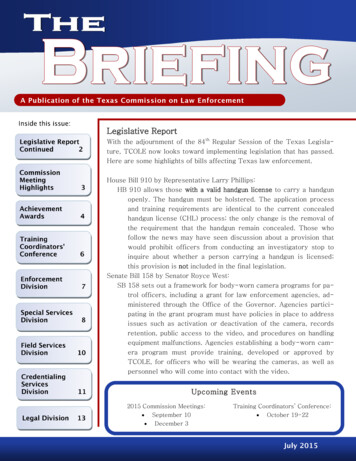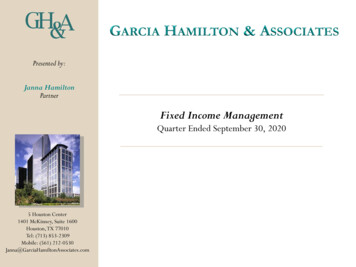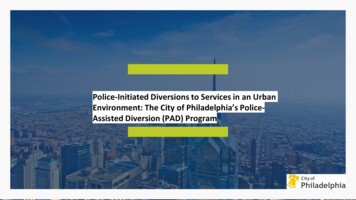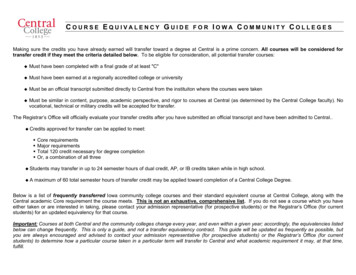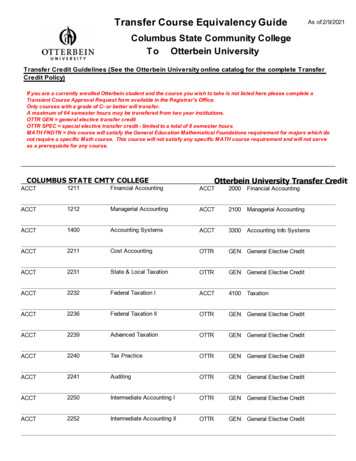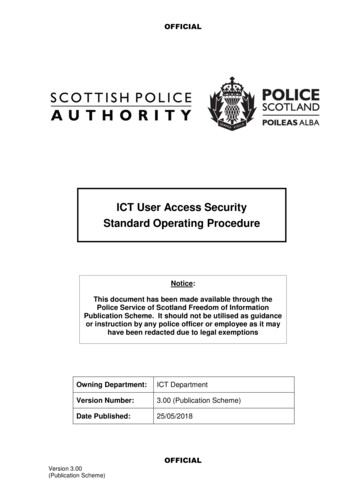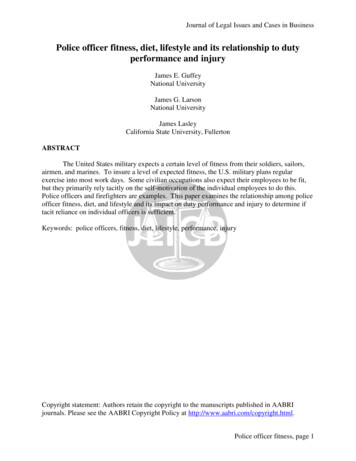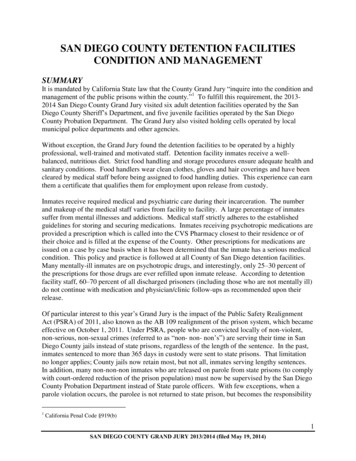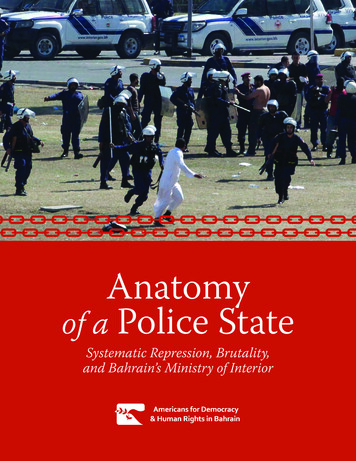
Transcription
Anatomyof a Police StateSystematic Repression, Brutality,and Bahrain’s Ministry of Interior
Anatomy of aPolice StateSystematic Repression, Brutality,and Bahrain’s Ministry of InteriorAmericans for Democracy & Human Rights in Bahrain
2019, Americans for Democracy & Human Rights in Bahrain.All rights reserved.Americans for Democracy & Human Rights in Bahrain (ADHRB)is a non-profit, 501(c)(3) organization based in Washington, D.C.that fosters awareness of and support for democracy and humanrights in Bahrain and the Arabian Gulf.Americans for Democracy & Human Rights in Bahrain (ADHRB)1001 Connecticut Avenue NW, Suite 205Washington, D.C. 20036 USA(202) 621-6141www.adhrb.orgDesign and layout by Jennifer King
ContentsExecutive Summary. . . . . . . . . . . . . . . . . . . . . . . . . . . . . . . . . . . . . . . . . . . . . . . 5Methodology. . . . . . . . . . . . . . . . . . . . . . . . . . . . . . . . . . . . . . . . . . . . . . . . . . . . . 8Introduction . . . . . . . . . . . . . . . . . . . . . . . . . . . . . . . . . . . . . . . . . . . . . . . . . . . . 101 Background: Crime and Criminality in Bahrain. . . . . . . . . . . . . . . . . . . . . 122 Command and Control: Structure, Hierarchy, and Organization. . . . . . 16A. Senior Leadership . . . . . . . . . . . . . . . . . . . . . . . . . . . . . . . . . . . . . . . . . . . . . . . . . . . . . 17B. Lead Agencies and Directorates. . . . . . . . . . . . . . . . . . . . . . . . . . . . . . . . . . . . . . . . . . 22C. Support Agencies and Directorates. . . . . . . . . . . . . . . . . . . . . . . . . . . . . . . . . . . . . . . . 323 A Policy of Repression: Widespread and Systematic Abuses . . . . . . . . 38A. Arbitrary Detention and Warrantless Home Raids . . . . . . . . . . . . . . . . . . . . . . . . . . 39B. Enforced Disappearance. . . . . . . . . . . . . . . . . . . . . . . . . . . . . . . . . . . . . . . . . . . . . . . . 42C. Torture . . . . . . . . . . . . . . . . . . . . . . . . . . . . . . . . . . . . . . . . . . . . . . . . . . . . . . . . . . . . . . 43D. Due Process. . . . . . . . . . . . . . . . . . . . . . . . . . . . . . . . . . . . . . . . . . . . . . . . . . . . . . . . . . 48E. Detention Standards and Denial of Medical Care. . . . . . . . . . . . . . . . . . . . . . . . . . . 50F. Police Brutality and Extrajudicial Killing. . . . . . . . . . . . . . . . . . . . . . . . . . . . . . . . . . . 57G. Religious Discrimination . . . . . . . . . . . . . . . . . . . . . . . . . . . . . . . . . . . . . . . . . . . . . . . 644 Failure to Reform: Perpetuating the Cycle of Abuse. . . . . . . . . . . . . . . . 72A. Impunity . . . . . . . . . . . . . . . . . . . . . . . . . . . . . . . . . . . . . . . . . . . . . . . . . . . . . . . . . . . . 73B. Incentives. . . . . . . . . . . . . . . . . . . . . . . . . . . . . . . . . . . . . . . . . . . . . . . . . . . . . . . . . . . . 795 Foreign Assistance: American and International Support. . . . . . . . . . . 88A. United States . . . . . . . . . . . . . . . . . . . . . . . . . . . . . . . . . . . . . . . . . . . . . . . . . . . . . . . . . 89B. United Kingdom. . . . . . . . . . . . . . . . . . . . . . . . . . . . . . . . . . . . . . . . . . . . . . . . . . . . . . 102C. Canada. . . . . . . . . . . . . . . . . . . . . . . . . . . . . . . . . . . . . . . . . . . . . . . . . . . . . . . . . . . . . 105D. European Union. . . . . . . . . . . . . . . . . . . . . . . . . . . . . . . . . . . . . . . . . . . . . . . . . . . . . 1076 Conclusion and Recommendations. . . . . . . . . . . . . . . . . . . . . . . . . . . . . . 112ANATOMY OF A POLICE STATE Systematic Repression, Brutality, and Bahrain’s Ministry of Interior3
4ANATOMY OF A POLICE STATE Systematic Repression, Brutality, and Bahrain’s Ministry of Interior
Executive SummaryA comprehensive look at the core security agency driving Bahrain’s human rights crisis, Anatomy ofa Police State is the first full study of the Ministry of Interior (MOI) police force’s integral role in thekingdom’s repression of dissent. It reveals that the MOI has led Bahrain’s catastrophic devolution into apolice state even as it has received millions of dollars from countries like the United States (US) and theUnited Kingdom (UK), presenting overwhelming evidence of widespread gross human rights violationsperpetrated as a matter of government policy.Drawing on years of primary documentation, Americans for Democracy & Human Rights in Bahrain(ADHRB) analyzes over 1,000 discrete incidents of abuse comprising more than 3,000 specific rightsviolations attributable to MOI agencies from 2011 through to the present day, from arbitrary detentionand torture to rape and extrajudicial killing. The report demonstrates a clear pattern of police brutality andrepression at every command level of the MOI, with the same types of violations perpetrated by the sameunits consistently over time.Despite Bahraini government claims that misconduct is isolated to a few “bad apples,” our documentationproves that serious violations like torture are the product of de facto policy generated not just by a cultureof impunity, but also by a system of incentives aimed at rewarding perpetrators. As the government hasgradually tasked the MOI with enforcing new and more stringent prohibitions on fundamental freedoms, themost ruthless officers are distorted into the most effective officers – and they are promoted, not punished.No amount of superficial reform, training, or international assistance will prevent abuse when law enforcementhas become synonymous with repressing basic human rights. This is the reality of the modern Bahraini policestate, and the kingdom’s partners must immediately suspend cooperation with all those responsible within theMOI. Moreover, with a view toward stemming the tide of abuse and compelling real accountability measures,we urgently call on the international community to impose sanctions on key perpetrators across all MOIagencies and command echelons, up to and including Interior Minister Sheikh Rashid bin Abdullah Al Khalifa. Bahrain is among the most heavily policed countriesin the world, with approximately 45 MOI personnelfor every 1,000 civilians. That is more than doublethe comparable rate at the height of SaddamHussein’s dictatorship in Iraq, which dwarfedsimilar regimes in Iran and Brazil. The MOI police force is the single most abusivegovernment agency in Bahrain, with more than1,000 incidents of severe abuse documented byADHRB within a seven-year period. For comparison,that is 200 more cases than were recorded by the USWar Crimes Working Group for the 20-year conflictin Vietnam. As many as one in every 635 Bahrainis has beenarbitrarily detained, disappeared, tortured, raped,killed, or otherwise abused by the police accordingto our data. In just our sample subset, the MOI isdirectly implicated in 570 cases of torture and 517arbitrary detentions, with personnel committingaround 400 specific human rights violationsannually, including 13 sexual assaults per year.KEY FINDINGSKEY FINDINGS:45 MOI personnelfor every 1,000 civiliansmore than1,000 incidentsof severe abuse withina seven-year period570cases of torture517arbitrary detentions40013specific human rightsviolations annuallysexual assaults per yearANATOMY OF A POLICE STATE Systematic Repression, Brutality, and Bahrain’s Ministry of Interior5
The oversight mechanism meant to hold policeaccountable, the MOI Ombudsman, has referred just5% of cases for serious prosecution. At the end of 2017,only three police officers were in prison. The senior-level officer cadre is virtually immune fromprosecution and has been continuously promoted since2011 with the explicit approval of the king, prime minister,or interior minister. Of 12 senior commanders identifiedby ADHRB within the MOI’s top 8 abusive units, everysingle one reached a higher rank or command postdespite evidence of severe rights violations. Just onefaced prosecution, and he was promptly acquitted andpromoted.Throughout this period of escalating repression, Bahrain’schief western allies have consistently trained, funded, andequipped the MOI’s most brutal sub-agencies – with morethan 13 million in support from the US and UK alone. Ourreport finds that: Despite ongoing restrictions on American arms salesto the MOI over rights concerns, police continue toreceive training for their largely US-made arsenal. From 2007 to 2017, the American taxpayer providednearly 7 million in security assistance to the MOIand specifically the riot police – a notorious nationalpolice force responsible for dozens of extrajudicialkillings, countless protest raids, and reprisal attacks onprisoners.KEY FINDINGS Bahrain has the highest rate of mass incarcerationin the Middle East, with thousands held in MOIdetention centers that universally violate internationalstandards.highest rate of massincarceration in theMiddle EastApprox.1 in every 152Bahrainis is jailed5 95 LOnly 3 officers inprison by 2017MOI Ombudsman,has referred just5% of casesfor serious prosecution President Donald Trump is now reviving MOItraining programs that declined after units failedLeahy Law vetting under the Obama Administration,proposing an extensive 10-course program for 2019 thatincludes advice on “attack methodologies.” The UK, which played a direct role in the formation of theBahraini police during the 20th century, has provided over 5 million to the MOI and the kingdom’s accountabilitymechanisms, taking no steps to limit cooperation. Canada and France, likewise, are supporting programsfor the MOI’s medical division, which is infamous fordenying medical care to detainees and interfering intorture investigations. Companies from the UK, Canada, Italy and elsewherehave sold surveillance technology to the MOI inviolation of export controls, directly enabling police totrack and detain human rights activists.612 seniorcommandersimplicated in violationsacross the top 8most abusive unitshave beenpromotedANATOMY OF A POLICE STATE Systematic Repression, Brutality, and Bahrain’s Ministry of Interior
ACRONYMSADHRBBCHRAmericans for Democracy & Human Rights in BahrainBahrain Center for Human RightsBICIBahrain Independent Commission of InquiryBIRDBahrain Institute for Rights and DemocracyBNACIDBahrain News AgencyCriminal Investigation DirectorateDHSUnited States Department of Homeland SecurityDODUnited States Department of DefenseDOSUnited States Department of StateFSCIDGDAEESGDCIFSGDRRForensic Science/Criminal Information DirectorateGeneral Directorate of Anti-Corruption, Economic, and Electronic SecurityGeneral Directorate of Criminal Investigation and Forensic ScienceGeneral Directorate of Reformation and RehabilitationGSSGeographical Security SystemMOIMinistry of InteriorMOJMinistry of Justice and Islamic AffairsNACNational Ambulance CenterNIHRNational Institute for Human RightsNPRANationality, Passports, and Residence AffairsNSAOHCHRPDRCNational Security AgencyOffice of the High Commissioner for Human RightsPrisoners and Detainees Rights CommissionPPOPublic Prosecution OfficeSIUSpecial Investigations UnitSSFCSpecial Security Force CommandUNUnited NationsUSUnited StatesUKUnited KingdomUPRUniversal Periodic ReviewANATOMY OF A POLICE STATE Systematic Repression, Brutality, and Bahrain’s Ministry of Interior7
METHODOLOGYUnless otherwise indicated, the statistics presented in this report are drawn from ADHRB’s United Nations(UN) Complaint Program and internal case database, which are in turn based on extensive interviews andprimary documentation obtained through our fieldworkers and processed by our legal team. Not everycase included in the dataset has been published or formally taken up by the UN Special Procedures. Whenappropriate, the dataset is augmented by reliable open-source information.Each entry in the database represents a discrete case or incident, which typically comprises multiple distincthuman rights violations (e.g. arbitrary detention, enforced disappearance and torture are three separate butinterrelated violations that commonly occur within one case of abuse against a targeted person). The vastmajority of the entries also represent distinct individuals, however several individuals have been involvedin multiple cases of abuse, and are therefore entered into the database more than once. These cases accountfor approximately two percent of total entries. A small number of entries reflect mass incidents withoutreference to distinct individuals, such as protest raids. These entries likely underrepresent the number ofvictims, as ADHRB is unable to verify the total number of affected individuals; as a result, these are countedas merely one use of excessive force or violation of free assembly, which again likely underrepresents thetrue scale of the abuse (see below).Because of the extreme restrictions on human rights work in Bahrain, as well as the nature of the abuses wedocument, the dataset is not a random sample: it is a collection of the cases recorded by our fieldworkers.It is therefore inherently limited by their access to documents and witness testimony, as well as ADHRB’scapacity to formally process complaints. Due to fear of reprisal, it is assumed that many cases of abuse gounreported or undocumented. Others will only emerge after considerable time has elapsed. When possible,we continue to document incidents that have occurred years in the past, once survivors and witnesseshave resolved to provide information about the abuse – in many cases after relevant individuals have beenreleased from government custody.Our dataset is also necessarily limited by our complaint procedures themselves, which are structuredprimarily around individual incidents that can be corroborated through testimony, court documents,hospital records, and other primary evidence. Such procedures help to ensure accuracy, but they alsorequire extensive, often risky cooperation with relevant parties. This makes it easier to document incidentswith multiple witnesses that are formally entered into the Bahraini criminal justice system, while moredifficult to document spontaneous acts of police brutality or enforced disappearance. As a result, comparingthe frequency between certain abuses in our database may yield distorted conclusions – for example, wehave formally documented far more cases of torture committed during arbitrary detentions than the useof excessive force against protesters, though we have reason to believe that the latter is almost equally ascommon as the former. This discrepancy does not exist because cases of excessive force are infrequent,it exists because a) it is rare for all victims to be formally arrested in such incidents; b) they are typicallyforced to seek informal medical care; and c) they are often unable or unwilling to file complaints dueto fear of detection and retaliation, among other obstacles. As noted above, in instances where we haveconfirmed mass incidents of excessive force have occurred but have not formally documented individualvictims, for example, we register the case as a singular abuse; this ensures incidents are not over-counted,but undoubtedly fails to reflect the full scope of police violence.In sum, the statistics presented here ultimately reveal trends specific to ADHRB’s documentation.Information drawn from our database is not meant to be interpreted as complete picture of human rightsviolations in Bahrain; on the contrary, it should be understood as a partial, representative glimpse at the fullscale of abuse. Because of the reasons outlined above, it is estimated that the true total number of abuses isexponentially higher, and the types of violations even more diverse.8ANATOMY OF A POLICE STATE Systematic Repression, Brutality, and Bahrain’s Ministry of Interior
A Note on Names:Due to a pattern of reprisal against individuals for communicating details of government abuses, particularlyto international human rights organizations, ADHRB has either omitted names or used pseudonyms whendescribing many of the cases cited in this report. When used, pseudonyms are marked with an asterisk (*).ADHRB has only included the actual names of individuals if their case has already been publicized, or withthe express permission of them or their families.A Note on Translations:The Bahraini government has not released a definitive list of English translations for its various governmentagencies and subdivisions, and its official English publications repeatedly refer to the same institutions bydifferent names. In some cases, an institution’s own documents will include a different English translationof its name than the physical sign located on its headquarters facility, which in Bahrain almost alwaysinclude both Arabic and English.For example, the General Directorate of Criminal Investigation and Forensic Science is regularly translatedseveral different ways by both official and unofficial sources, including: the General Directorate of CriminalInvestigation and Forensic Science; the General Directorate of Criminal Investigation and Evidence;the General Directorate of Criminal Investigation and Forensic Evidence; the General Directorate ofInvestigation and Criminal Identification; and the General Directorate of Crime Detection and ForensicEvidence, among other variations. Moreover, it is often conflated, both formally and colloquially, with itschief subdivision: the Criminal Investigation Directorate (and the acronym, CID), which is itself sometimesreferred to additionally as the Directorate of Criminal Investigations or the Department of CriminalInvestigation (“Department” and “Directorate” are typically used interchangeably to refer to the immediatesubdivisions of a General Directorate).When possible, this report refers to agencies by the English translation found on their physical headquarters,official insignia, or uniforms. In other cases, it refers to the agency by its most common translation. Forthe above example, the report uses “General Directorate of Criminal Investigation and Forensic Science(GDCIFS)” to refer to the overarching general directorate because this is the official English translationwritten on its physical headquarters; it uses “Criminal Investigation Directorate (CID)” to refer to the mainsubdivision, because that is its most common referent.If applicable, the report includes footnotes that provide other common translations when the agency inquestion is first introduced.ACKNOWLEDGEMENTSMuch of this documentation could not have been accomplished without the work of our partners at theBahrain Center for Human Rights (BCHR), the Bahrain Institute for Rights and Democracy (BIRD), andthe European Centre for Democracy and Human Rights (ECDHR). It would be virtually impossible withoutthe work of activists in Bahrain who take immense risks to record and communicate this information.Warning: This report contains graphic images.ANATOMY OF A POLICE STATE Systematic Repression, Brutality, and Bahrain’s Ministry of Interior9
ADHRB alone has documented over 1,000discrete incidents of severe abuse comprisingmore than 3,000 specific rights violationsattributable to MOI agencies from 2011through to the present day. For comparison,that is 200 more cases than were recordedby the US War Crimes Working Group for the20-year conflict in Vietnam.State Terror, Gross HumanRights Violations,and Policing in Bahrain
Bahrain is one of the most heavily policed countriesin the world. While the government does notprovide detailed information on the Ministry ofInterior (MOI) – Bahrain’s chief law enforcement agency –estimates put its strength at 11,0001 officers supplementedby another 15,000-20,000 civilian staff in support roles.2With a citizen population of approximately 665,000,3this means that Bahrain maintains roughly 45 securitypersonnel per 1,000 civilians.4 That is an enormous ratethat places Bahrain among history’s most oppressiveregimes – more than double the relative number of policeper civilians at the height of Saddam Hussein’s dictatorshipin Iraq,5 which at the time dwarfed comparable policestates in Iran and Brazil.6The MOI has only continued to expand since its leadingrole in the violent suppression of Bahrain’s 2011 protestmovement, with the government recruiting thousandsmore personnel and adding entire new departmentsover the last seven years. Easily the largest and mostactive security institution – if not the single largest andmost active government agency – it sits at the centerof the kingdom’s extensive and overlapping securityinfrastructure, coordinating operations between Bahrain’smilitary, national guard, intelligence community, as well asthe MOI’s own vast number of interrelated subdivisions. Asin a classical police state like Ba’athist Iraq, the boundariesbetween these various agencies are ill defined, withredundant ambits meant to ensure that no one escapesBahrain’s near-absolute prohibition on dissent. And, as theprimary policing authority, the MOI and its personnel aredirectly involved in nearly every case of arbitrary arrest,torture, enforced disappearance, excessive force, andextrajudicial killing in the kingdom.In, Anatomy of a Police State, Americans for Democracy& Human Rights in Bahrain (ADHRB) traces Bahrain’sevolution into one of the world’s most draconian policestates by examining its principal tool of repression: theMOI. Drawing on years of primary documentation andresearch – including formal complaints processed withthe United Nations (UN) Special Procedures – the reportpresents evidence of widespread and systematic humanrights violations at every command level of the MOI’score agencies, with the same types of violations occurringconsistently through time. ADHRB alone has documentedover 1,000 discrete incidents of severe abuse comprisingmore than 3,000 specific rights violations attributable toMOI agencies from 2011 through to the present day. Forcomparison, that is 200 more cases than were recorded bythe US War Crimes Working Group for the 20-year conflictin Vietnam.7 According to our data, as many as one inevery 635 Bahrainis has suffered an extreme human rightsviolation at the hands of the MOI, with police committingmore than a hundred serious abuses a year.Despite Bahraini government claims that misconductis isolated to a few “rotten apples,”8 our documentationproves that serious violations like torture are the productof de facto policy generated not just by a “culture ofimpunity,” but also by a system of incentives aimed atrewarding perpetrators. As the government has graduallytasked the MOI with enforcing newer and more stringentbans on fundamental freedoms, the most ruthless officersare distorted into the most effective officers – and they arepromoted, not punished. The system is not broken, thisis how it is was designed by the ministry’s top leadershipcadre – up to and including Interior Minister SheikhRashid bin Abdullah Al Khalifa. No amount of superficialreform, training, or international assistance will preventabuse when law enforcement has become synonymouswith repressing basic human rights and deflecting scrutiny.This is the reality of the modern Bahraini police state.1 K.T. Abdulhameed, “Bahrain’s Migrant Security Apparatus,” in Abdulhadi Khaladf, Omar al-Shehabi, and Adam Hanieh, Eds., Labor Migration and Citizenship in the Gulf,Pluto Press: 2015, Print.2 In 2010, Bahrain’s Central Informatics Organisation reported that 82,679 people worked in the “public administration and defense sector” (K.T. Abdulhameed, “Bahrain’sMigrant Security Apparatus,” in Abdulhadi Khaladf, Omar al-Shehabi, and Adam Hanieh, Eds., Labor Migration and Citizenship in the Gulf, Pluto Press: 2015, Print.). A yearlater, the Interior Minister announced that the MOI would be adding around 20,000 additional personnel to the MOI, indicating that it already maintained significant highemployment, and that – if these employment goals were met – it may have grown even larger than these estimates suggest in recent years (“Bahrain’s Ministry of Interior tocreate 20,000 jobs; announcement seen as move to give Shi’ites jobs,” Reuters, 6 March 2011, vernment-jobs-protestscontinue-384994.html). For further reference: combined, the Bahraini military and the National Guard employ approximately 15,600-23,600 people (low-end estimate versushigh-end estimate, respectively). Employment figures for Bahrain’s intelligence services, like the NSA, are unknown. For more information on employment figures anddemographic trends in Bahrain’s security sector, see: Sectarian Discrimination and Extremism in Bahrain’s Security Forces, ADHRB, November 2017, 17.Sectarianization-of-Security-Forces White-Paper.pdf3 Bahrain in Figures – 2016, Information & eGovernment Authority, Kingdom of Bahrain, 2017, http://www.data.gov.bh/4 Even if only half of the MOI’s total personnel are actually involved in policing roles, that still brings the figure to approximately 23 per 1,000 civilians – two more than inBa’athist Iraq, which maintained 21 police officers for every 1,000 civilians. Moreover, these estimates include only MOI personnel; they do not account for the thousands moremilitary, national guard, and intelligence officers that Bahrain employs in domestic security.5 Kanan Makiya, Republic of Fear: The Politics of Modern Iraq, University of California Press: Berkeley and Los Angeles,1989 (updated edition, 1998), Print. 38.6 Sam Jones, “Building the Ba’athist Police State: A Converstaion with Kanan Makiya,” Unpublished Interview, 2016, Transcript Available Upon Request.7 Nick Turse, Kill Anything That Moves: The Real American War in Vietnam, Picador, 2013, Print.8 Marc Owen Jones, “Rotten apples or rotten orchards: Police deviance, brutality, and unaccountability in Bahrain,” in Eds. Ala’a Shehabi and Marc Owen Jones, Bahrain’sUprising, Zed Books, 2015, Print.ANATOMY OF A POLICE STATE Systematic Repression, Brutality, and Bahrain’s Ministry of Interior11
1Background:Crime and Criminalityin Bahrain
There is an extreme mismatch between Bahrain’srate of policing and its rate of crime. By allobjective metrics, the kingdom has exceptionallylittle criminal activity, with some indices ranking itamong the lowest in the world.9 The United States (US)Department of State (DOS) ranks Bahrain as a “low-threat”for crime, reporting that violent offenses are particularlyrare.10 Common infractions include “various types ofimmigration and residency fraud, ATM/credit card theft,white collar fraud, embezzlement, possession or traffickingof illegal narcotics, and property theft.”11 It assesses Bahrainas a “medium-threat” for terrorism due to its geographiclocation and political situation,12 documenting a declinein terror activity for 201613 followed by a nominal uptickin 2017.14 The MOI’s own figures demonstrate a gradualdecrease in all types of crime over the last several years,including a “21 per cent reduction in cases received by 911[sic]” in 2017.15Bahrain’s moderate criminal profile is the first indicationthat its massive, militarized police force is not a product oframpant crime – but of rampant criminalization.Since Bahrain’s current king took the throne in 2001 andparticularly since the 2011 pro-democracy movement, thegovernment has issued or amended a dizzying array oflaws and policies aimed at limiting fundamental freedoms.Countless acts of nonviolent free expression, assembly,belief, and association have been reclassified as nationalsecurity offenses and crimes against the state. As observedby the United Nations (UN) Working Group on ArbitraryDetention, many “provisions of [Bahrain’s] Penal Code areso vague and overly broad that they could . [and do] resultin penalties being imposed on individuals who had merelyexercised their rights under international law.”16 Anti-terrorand cybercrime legislation have likewise grown to envelopthe most basic forms of peaceful dissent as terrorism orcyber-terrorism with catchall offenses like “insulting theking,” inviting violent counterterror responses.9 For example, see Bahraini pro-government blog “Citizens for Bahrain” - “Ten reasons why Bahrain is best - #3 personal safety,” Citizens for Bahrain, 29 June 2015, 10 Bahrain 2017 Crime & Safety Report, Overseas Security Advisory Council, DOS, United States Government, 2017, px?cid 2124511 Ibid.12 Ibid.13 “Bahrain: US State Department Documents Decline in Terrorism Last Year, Continued Rights Concerns,” ADHRB, 21 July 2017, -concerns/14 “US State Department Cites Bahrain’s Political Repression as Major Risk Factor for Instability,” ADHRB, 20 September 2018, actor-for-instability/15 “Pride of the Nation: Crown Prince Praises New Security Officers,” Al-Amn, Police Media Center, MOI, Kingdom of Bahrain, n-magazine/5910016 “Mr. Rajab has been arrested, detained, prosecuted and imprisoned for allegedly spreading false news abroad which damages the national interest and for allegedlyspreading false rumours in wartime, insulting governing authorities and insulting a foreign country — pursuant to articles 133, 134, 215 and 216 of the Penal Code Theseprovisions of the Penal Code are so vague and overly broad that they could, as in the present case, result in penalties being imposed on individuals who had merely exercisedtheir r
Americans for Democracy & Human Rights in Bahrain (ADHRB) is a non-profit, 501(c)(3) organization based in Washington, D.C. that fosters awareness of and support for democracy and human rights in Bahrain and the Arabian Gulf. Americans for Democracy & Human Rights in Bahrain (ADHRB) 1001 Connecticut Avenue NW, Suite 205 Washington, D.C. 20036 USA


